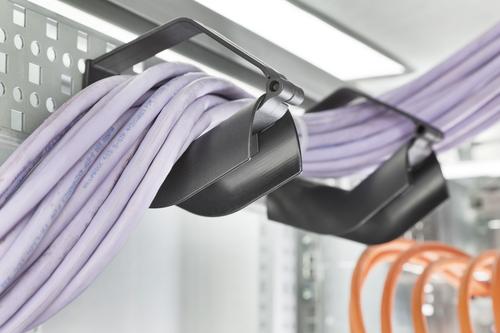March 11, 2014
Today's complex network wiring systems demand performance and reliability. Consistent and organized wiring is critical to optimizing performance, system changes, scalability, and reduced maintenance costs.
A common challenge faced by installers when assembling or upgrading equipment housed inside enclosures is achieving consistent placement and organization of the wiring cables. Although wire routing plans are often provided for installers to follow, it is quite common for different installers or maintenance personnel to access the cabinet and modify the wiring at different times throughout the life cycle of the cabinets. There is no guarantee that these wiring plans will be consistently followed by the various installers initially setting up the wiring in the cabinets. In addition, as system requirements change over time and new wiring cables are added or modified to meet performance demands, it can be difficult to follow original routing plans to accommodate these changes.

The existing selection of cable management devices available for use in these applications is one of the causes of inconsistent placement and disarray of wiring systems. Traditional wiring devices, such as cable mounts, can create problems when companies are trying to achieve organized and effective wiring systems. Whether selecting adhesive mount or screw mount cable management devices, the decision of where to attach these devices is often at the discretion of the individual installer. Many times these cable management devices are placed wherever it is convenient for the installer at that particular time, or wherever there may be unoccupied space available inside the cabinet. As wiring systems are added or changed for upgrades or new installations, open space becomes very limited.
Of the existing cable management devices, adhesive mounts are the most common selection. They are appealing to installers and companies alike because adhesive mounts have two key advantages; they can be placed anywhere inside of a cabinet and they are a lower cost option. But more important are the disadvantages that are commonly faced when using adhesive mounts to achieve an organized and effective wiring system.
In order to use these devices, the surface must be properly prepared and cleaned. This can be both a time-consuming and tedious process, and sometimes involves the use of chemicals. After applying the adhesive, installers must wait a considerable amount of time to make sure it has set properly. Being able to place adhesive anywhere is also a disadvantage because it can lead to great inconsistencies in the wiring organization process. Installers can place the adhesive wherever is most convenient for them rather than following a wire routing plan. This leads to discrepancies and disorganization in the placement of the wiring.
But the primary challenge when selecting adhesive mount wiring devices is the short lifespan of the adhesive. Over time, the glue on the adhesive will wear off and needs to be replaced on a regular basis. Temperature fluctuations and humidity can also greatly affect and decrease the longevity of the adhesive. This is of particular concern in outside cabinet applications where variations in high and low temperatures can be more extreme. In these situations, maintaining a consistent, neat, and organized wiring system can be challenging for field technicians or maintenance personnel. Until recently, there were few products available specifically designed to ensure a consistent initial wiring system at set-up and that are able to maintain a consistent, neat, and organized wiring system over the product's lifetime.
About the Author(s)
You May Also Like





